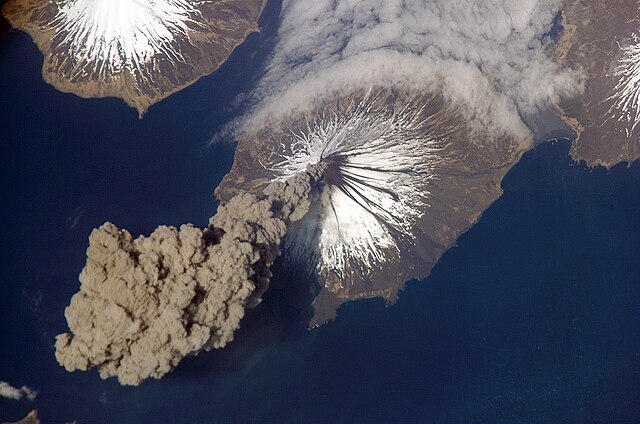An eruption column or eruption plume is a cloud of super-heated ash and tephra suspended in gases emitted during an explosive volcanic eruption. The volcanic materials form a vertical column or plume that may rise many kilometers into the air above the vent of the volcano. In the most explosive eruptions, the eruption column may rise over 40 km (25 mi), penetrating the stratosphere. Stratospheric injection of aerosols by volcanoes is a major cause of short-term climate change.
Eruption column over Mount Pinatubo in the Philippines, 1991
Eruption column rising over Redoubt Volcano, Alaska, on 21 April 1990, which reached a height of about 9 km (5.6 mi)
The eruption column produced by the 1980 eruption of Mount St. Helens as seen from the village of Toledo, Washington, which is 56 km (35 mi) away. The cloud was roughly 64 km (40 mi) wide and 24 km; 79,000 ft (15 mi) high.
Volcanic ash consists of fragments of rock, mineral crystals, and volcanic glass, produced during volcanic eruptions and measuring less than 2 mm (0.079 inches) in diameter. The term volcanic ash is also often loosely used to refer to all explosive eruption products, including particles larger than 2 mm. Volcanic ash is formed during explosive volcanic eruptions when dissolved gases in magma expand and escape violently into the atmosphere. The force of the gases shatters the magma and propels it into the atmosphere where it solidifies into fragments of volcanic rock and glass. Ash is also produced when magma comes into contact with water during phreatomagmatic eruptions, causing the water to explosively flash to steam leading to shattering of magma. Once in the air, ash is transported by wind up to thousands of kilometres away.
Ash cloud from the 2008 eruption of Chaitén volcano, Chile, stretching across Patagonia from the Pacific to the Atlantic Ocean
Ash plume rising from Eyjafjallajökull on April 17, 2010
Volcanic ash deposits on a parked McDonnell Douglas DC-10-30 during the 1991 eruption of Mount Pinatubo. While falling ash behaves in a similar manner to snow, the sheer weight of deposits can cause serious damage to buildings and vehicles. In this case, volcanic ash deposits shifted the airliner's center of gravity, leading to it resting on its tail.
Ash plume from Mt Cleveland, a stratovolcano in the Aleutian Islands







